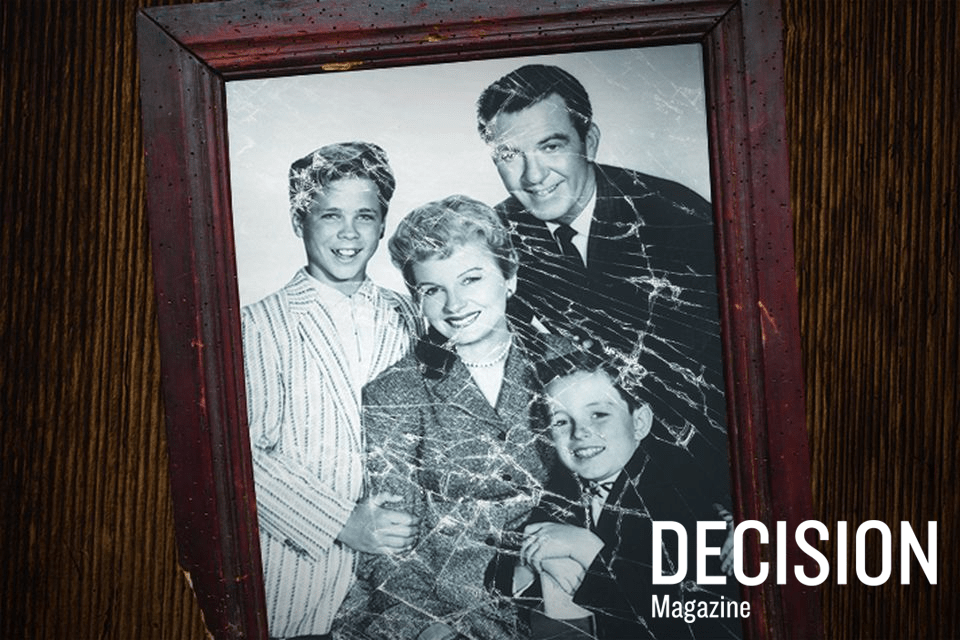
Ruth Graham’s statement years ago to Billy that “If God doesn’t punish America, He’ll have to apologize to Sodom and Gomorrah” is often quoted. Increasingly, it looks like judgment has arrived. In fact, the celebration of deviant sexuality has become a kind of cultural litmus test. Meanwhile, the “rights” of sexual license are audaciously pitted against constitutional guarantees of religious freedom. And although the 1960s mantra of “free love” is long past, the free love ethos of the sexual revolution continues to incur exorbitant social and spiritual costs.
The judgment Mrs. Graham spoke of has been evident for several decades, says Richard D. Land, president of Southern Evangelical Seminary in Charlotte, N.C., who served 25 years as president of the Ethics & Religious Liberty Commission of the Southern Baptist Convention.
Land said he witnessed the early years of the sexual revolution while a student at Princeton University and has spent years afterward working to counter its deleterious effects—from immoral public policy championed by elected officials to myriad social woes.
“Frankly, the sexual revolution has done more damage to this country than anything ever has,” he said.
In 1967, spurred on by a gradual cultural slide, the budding sexual revolution had a coming-out party—infused with sex, LSD and rock ’n’ roll—in San Francisco’s Haight-Ashbury district. That “Summer of Love” inaugurated an effort to cast off traditional morals for a new vision of freedom, love and enlightenment.
It succeeded wildly—and failed miserably.
The Bitter Fruit
Almost 50 years later, nearly half of all first-time births are to unwed mothers, mostly in their 20s (U.S. Centers for Disease Control figures); some 55 million babies have died from legal abortion since 1973; homosexuality, still a closeted practice in the ’60s, is the cause du jour; rampant pornography is causing deep social and spiritual rot; HIV/AIDS has claimed 39 million lives since 1981, according to the World Health Organization; and marriage has been defaced and devalued.
Subscribe to Decision
Get your own subscription, or renewal, or bless someone by giving Decision Magazine as a gift.
SUBSCRIBE NOW
The historical landmarks for what transpired—Alfred Kinsey’s dubious sex research, the Playboyphilosophy of Hugh Hefner, Helen Gurley Brown’s cynical notion of female fulfillment, the normalization of homosexuality—all promised liberation but led to something else.
Free love turned out to be “neither free, nor love,” syndicated columnist Cal Thomas told Decision when asked to elaborate on a column he wrote following Brown’s death. Brown was essentially Hefner’s female counterpart, selling women a materialist view of sex as an author and as editor of Cosmopolitan magazine for 32 years.
“We must remember that our adversary dresses up thoughts and behavior to look, sound and feel good,” Thomas said. “‘If it feels good, do it’ was another slogan from that disastrous decade. The costs have been monumental—divorce, leaving children with the belief that if they can be abandoned by earthly parents, perhaps they can’t count on a heavenly Father to love them unconditionally.”
In his column, Thomas wrote: “In any revolution—political, or the sexual one championed by those like Hefner and Brown—there are casualties. No one wants to talk about the casualties of the sexual revolution because that wouldn’t sell magazines or seduce a new generation of young people. Sex sells, but it also brings misery when it’s misused.”
Sexual rebellion is ancient. But the modern roots of this revolt are linked to 19th century radicals who believed “all sexual morality was a form of oppression,” says R. Albert Mohler Jr., president of Southern Baptist Theological Seminary in Louisville, Ky.
A rising theological liberalism that questioned biblical authority also hastened the change in sexual mores, Mohler said, as did the advent of modern birth control.
In fact, the family planning movement ushered in “an entire birth control worldview—a worldview that was very injurious to marriage and resulted in the widespread acceptance of premarital sex and eventually of divorce,” Mohler told Decision.
These developments “set the stage for the sexual revolution as we now know it,” Mohler said. “The normalization of homosexuality would have never been possible had these other cultural and worldview transformations not taken place first.”
The Biggest Loser: Marriage
Long before the term gay marriage was coined, traditional marriage was faltering. Of the sexual revolution’s fallout, marriage—God’s first institution, society’s building block and a living metaphor for the Gospel union of Christ and the church—got the worst of it.
In the 1970s, divorce rates rose steeply—fueled by greater acceptance of adultery and the passage of no-fault divorce laws. Eventually, the divorce culture hit the church, much like it did the wider culture.
“If the people sitting in the pews are fornicators and adulterers, the church will destroy marriages much more quickly than those outside the church,” actor and Christian apologist Kirk Cameron told The Birmingham News in an interview last year.
And even though recent data show divorce rates dropping, it’s not all good news. Those numbers don’t account for the fact that fewer young adults are marrying, writes Kay Hymowitz, a family and marriage researcher at the Manhattan Institute, in an article on Time magazine’s website.
As Hymowitz and the other authors of a study titled Knot Yet: The Benefits and Costs of Delayed Marriage in America noted, today’s young adults tend to see marriage as a “capstone” to be achieved, not a “cornerstone” to build on. And those who marry tend to be more educated and upwardly mobile than their unmarried peers.
In short, love and marriage don’t necessarily go together for many young adults. Marriage can wait, but sex and children need not.
The latest available data from the U.S. Centers for Disease Control and Prevention (CDC) show 48 percent of first-borns and 41 percent of all babies are born to unmarried mothers, mostly in their 20s, who are either still waiting for Mr. Right, or cohabitating in unstable relationships. In 1960, only 5 percent of all American births were to unwed mothers, the CDC reported.
The social costs are severe and residual. Research published by Princeton University and the Brookings Institution found that children born outside marriage “reach adulthood with less education, earn less income, have lower occupational status, are more likely to be idle (that is, not employed and not in school), are more likely to have a non-marital birth (among daughters), have more troubled marriages, experience higher rates of divorce, and report more symptoms of depression.”
As Thomas noted: “Throughout history a stable, two-parent home has been essential for stabilizing societies and rearing children in ways that promote their own stability. The damage caused to heterosexual marriage, from without by same-sex ‘marriage’ as well as within from divorce and cohabitation, is partly responsible for the societal chaos we now face.”
Women bear the brunt of the sexual revolution’s impact, often left to raise children alone while the pool of marriage-worthy men shrinks. For cohabitating women, those relationships don’t translate to long-term stability.
“About two-thirds of those couples break up before their child’s fifth birthday”—three times the rate of their married peers, the authors of the Knot Yet study wrote in a Wall Street Journal essay.
Compounding the problem is the phenomenon, noted prominently in recent years, of young men avoiding adult responsibilities, such as embarking on a career or marrying. Two possible culprits, pre-marital sex and ubiquitous pornography, lessen the resolve of young men to pursue marriage and related responsibilities, according to a new study from the Institute for the Study of Labor at the University of Bonn in Germany.
The study notes that marriage dropped by 39 percent in the United States between 1950-2010, but it dropped by 17 percent between 2000-2010 alone as digital technology exploded.
“We assert that the increasing ease of accessing pornography is an important factor underlying the decline in marriage formation and stability,” the study’s authors wrote.
The Scourge of Porn
With the prevalence of hard-core pornography, a predatory sexual culture has emerged, fueling the sex industry and fostering a rise in sexual assaults perpetrated by young men and boys.
Last September, President Obama announced the “It’s On Us” campaign to end campus sexual assault, telling reporters that such acts are “an affront to our basic humanity.”
While the president rightly laments a rise in sexual assault, adult obscenity laws are not being enforced at all, said Patrick A. Trueman, who headed the child exploitation and obscenity section at the Justice Department from 1988-93 and now serves as president of Morality in Media. There also has been very little enforcement of child pornography laws, Trueman said.
After the Internet emerged in the mid-1990s, and with it an explosion of digital porn, the Justice Department under three succeeding administrations has not enforced adult obscenity laws, Trueman said, adding that a lack of enforcement of adult pornography laws leads to greater prevalence of child porn as well. Consequently, Trueman added, “We have a pandemic of harm caused by pornography in our society today.”
Mohler asserts that sexual irresponsibility and predatory behavior by males tends to be eased in cultures that esteem marriage, and made worse by cultures that don’t. “This is simply true even in the most cursory reading of history,” he said.
“Marriage has a particular civilizing effect upon men, and Christians understand that it is deeper than a civilizing effect,” Mohler added. “Marriage has a spiritual impact upon men.”
While females may be less physically predatory, pornography has women in its crosshairs, says Rosaria Champagne Butterfield, formerly a tenured women’s studies professor and lesbian feminist, now a pastor’s wife, whose faith journey is detailed in her book The Secret Thoughts of An Unlikely Convert.
“Pornography affects women and girls as well as men,” Butterfield said. “It is not a man’s problem only. Pornography has a searing effect on people, and our daughters are at higher risk than we think.”
Women—not the stereotypical porn users—are at risk of porn addiction, research indicates. So-called “mommy porn” literature—such as the controversial Fifty Shades of Grey trilogy that has sold hundreds of millions of copies and is hitting the big screen—is indicative of how pop culture aims to distort biblical femininity.
The prolonged effect of sexual license is a society where “erotic liberty” now trumps constitutionally guaranteed religious liberties in the culture and even in the courts, Mohler wrote last fall amid growing legal recognition of homosexual marriages and a push for LGBTQ interests in cities across the country.
“The challenge we now face consigns every believer, every congregation and every religious institution to an arena of conflict where erotic liberty and religious liberty now clash,” Mohler said.
Is There Hope?
Land, the Southern Evangelical Seminary president, said today’s American culture shares similarities with ancient Corinth, where sexual immorality ran amok and had infiltrated the church. But the Gospel message is “a tougher sell than it was in the first century,” Land said, because America’s familiarity with Christianity, often skewed by stereotypes, makes for quicker resistance.
Yet, “there’s nothing in my Bible that says God can’t send revival, that God can’t send another awakening, before He comes back,” Land said. “When God’s people get right with God, lost people notice.”
Thomas, the syndicated columnist whose journalism career has spanned 10 presidential administrations, said that while cultural and political engagement are crucial to ensure workable policies, the Gospel is the only agent for lasting change.
“Christ is the only One with the power to transform a life and consequently a nation,” Thomas said. “A revival is the only solution to our multiple problems and those come only through effectual, fervent and what the late J. Edwin Orr called ‘a concert of prayer’ that seeks to glorify God, not us.” ©2015 BGEA
Give To Where Most Needed
